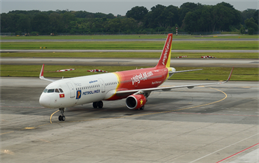
Vietjet Air has an ambitious and aggressive master plan which will see the airline enlarging its presence in the cargo market by launching freighter operations later this year, according to the CEO of its cargo division.
“We’ve decided to start operating freighters from the second quarter of 2018, with two Boeing 737-400Fs for short-haul flights,” said Do Xuan Quang, speaking at the first Asia Air Cargo Summit in Bangkok. “We plan to fly them to Saigon, Hanoi, Singapore, Bangkok and Hong Kong. At the end of 2018, we will introduce more 737-400F aircraft into our fleet.”
Under the carrier’s three-phase master plan, the first stage focuses on narrowbody belly space, mainly to domestic and regional destinations around Southeast Asia. This has been the case for the past few years and the company is now moving onto the second phase, which involves the use of narrowbody belly capacity as well as narrowbody freighters, and collaboration with international long-haul freighter operators. In phase three, Vietjet plans to use belly space and mid-size freighters, with Quang specifically pointing to the Airbus A330-200F.
The amount of belly space is also set to expand significantly. Vietjet’s current fleet consists of 39 A320s and 13 A321s, but the airline has 120 A320 family and 100 Boeing 737 MAX aircraft on order. This year, it is due to receive one new Airbus every month, while from 2019, 20 Airbus and 20 Boeing aircraft will be delivered every year.
Vietjet is truly stepping into uncharted territory here, given that the use of dedicated freighter aircraft is something that even a major player like AirAsia hasn’t yet attempted.
“Before we move into the market, we have to look at how a low-cost carrier operates,” said Mohd Yunus Bin Idris, managing director of VietjetAir Cargo. “Basically, it’s all narrowbodies, with an average flying time of not more than three hours. Sometimes there is no cargo between the city pairs. What part of the air freight chain are we going to be involved in? Is it just going to be express and small shipments?”
One important factor behind the decision to use separate aircraft for cargo lies in the fast-paced nature of an LCC.
“Our average turnaround time is not more than 27 minutes,” Bin Idris said. “How fast can you load and unload cargo, plus the passengers and their baggage? As an example, we have a city pair of Hanoi and Saigon. Hanoi exports a lot of industrial goods to Saigon. If we have a night stop in Hanoi then we can load all the cargo because we have a lot of time. We can have 300 pieces weighing just two tonnes – unloading this would take about 15 minutes.”
He added that, unlike some airlines, Vietjet doesn’t containerize the belly space in its narrowbodies, which means that it can still only deal with loose cargo.
Other indicators of Vietnam’s potential, according to Bin Idris, include the growing young population, increasing internet penetration and subsequent e-commerce, and the variety of things that the country produces. As he sees it, the role of an LCC like Vietjet is to transport goods between the two main hubs and the rest of the country.
“Looking at Vietnam, we’re talking about 4,000km from North to South,” he said. “To the East we have the South China Sea and to the West we have mountains. Hanoi is the biggest manufacturing centre for Samsung smartphones. We also have perishable seafood in the South China Sea. In the mountains we have flowers, fruits and vegetables. These are all exports that need capacity.”
Vietnam handled a total of 1.37 million tonnes of air cargo in 2017, a year-on-year growth of about 24%, and annual throughput is estimated to reach 2.5 million tonnes in 2020. But of the 17 freighter operators that serve Hanoi and Saigon with a total of 75 aircraft every week, not a single one is Vietnamese. This lack of a locally registered “home-grown” cargo carrier, combined with the growth potential of the country, has Quang and Bin Idris excited.
“When we made the decision to operate freighters, we studied and analyzed the Vietnam market closely,” said Quang. “On average, the ratio of belly to freighter capacity in a given country is about 70:30. In Vietnam, there should be a little more than 1 million tonnes of international cargo this year. The current freighter fleet in Vietnam carries only about 150,000 tonnes, which means there is still demand for 150,000 tonnes of freighter capacity.”
With Asia being such a fast-growing market for air cargo and Vietnam in particular being a mostly export-driven economy, Quang is convinced that there is a future in the market for Vietjet, which he likes to call not a low-cost carrier but a “new-age” carrier.
“Vietjet, after five years of operations, is already very successful in the passenger business,” he said. “This year, we will also aim to be as successful in the freighter business.”
By Jeffrey Lee
Asia Cargo News | Bangkok




